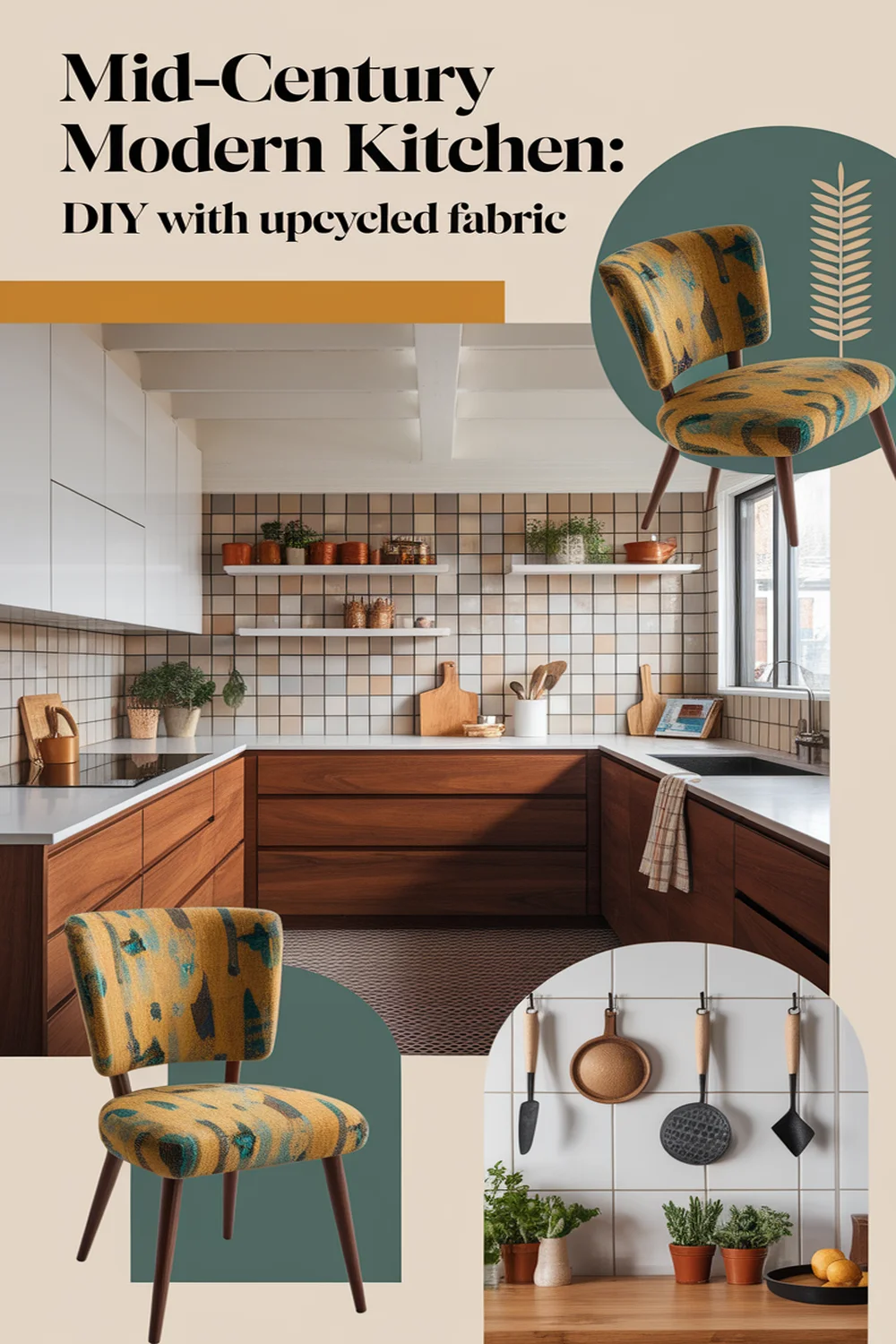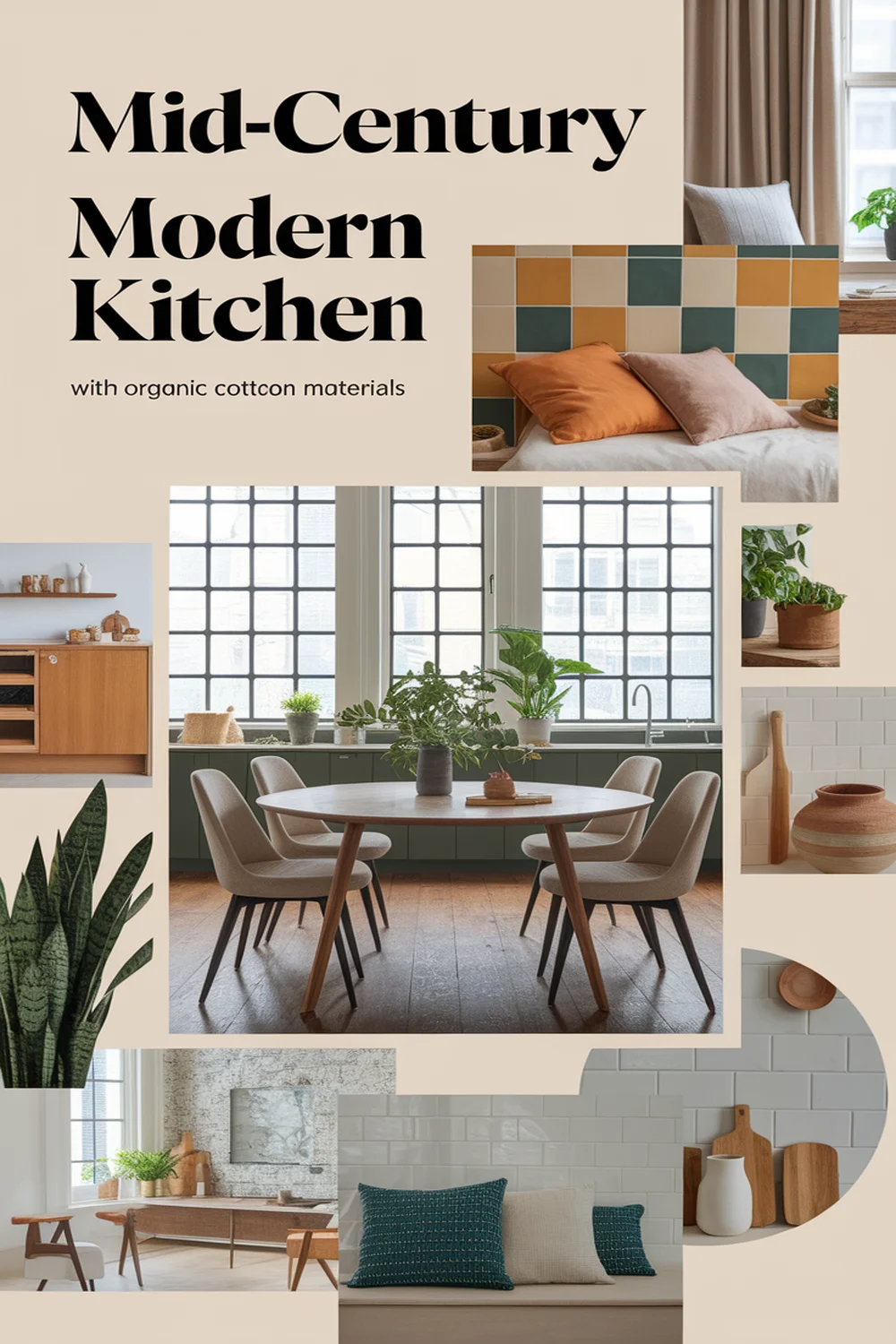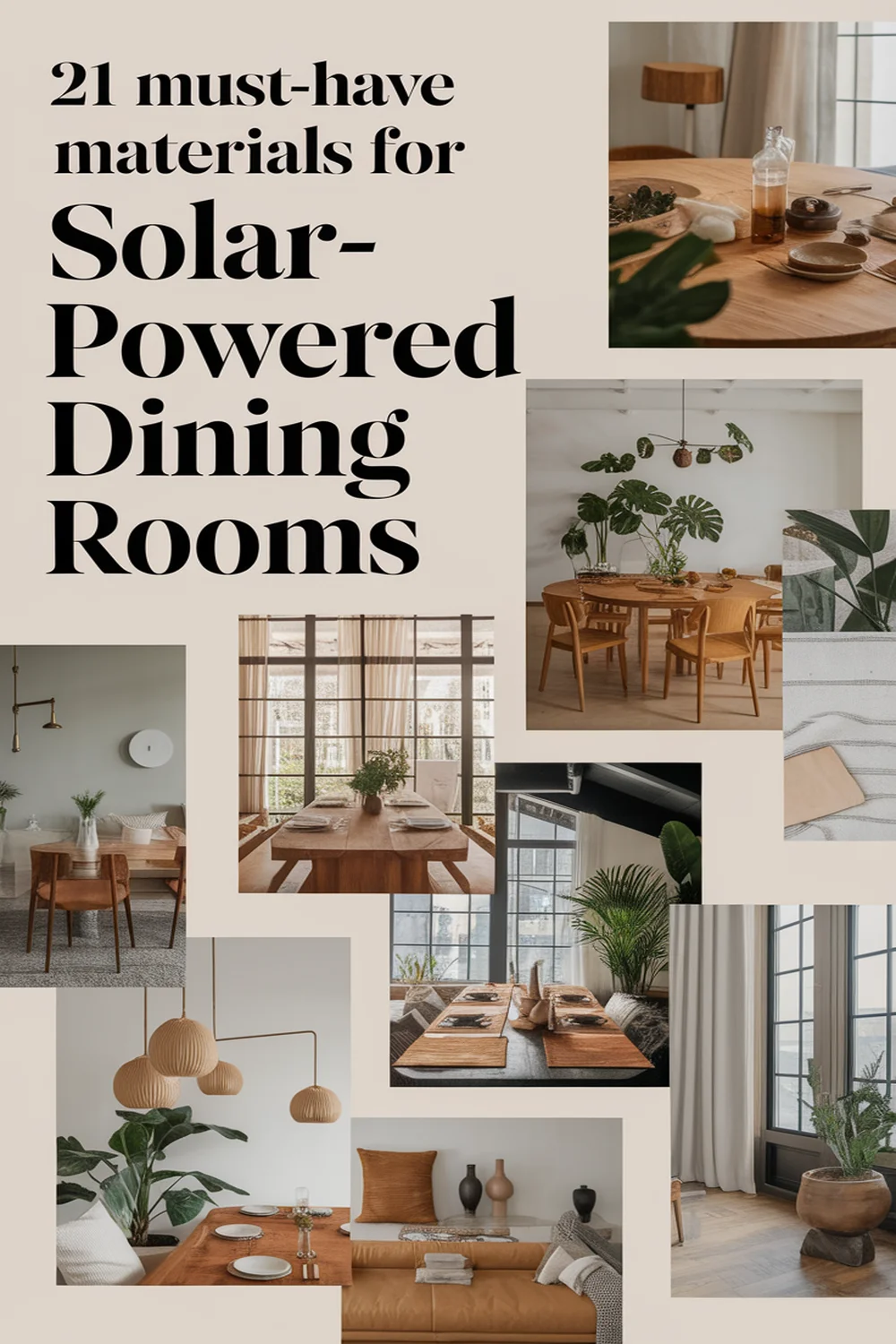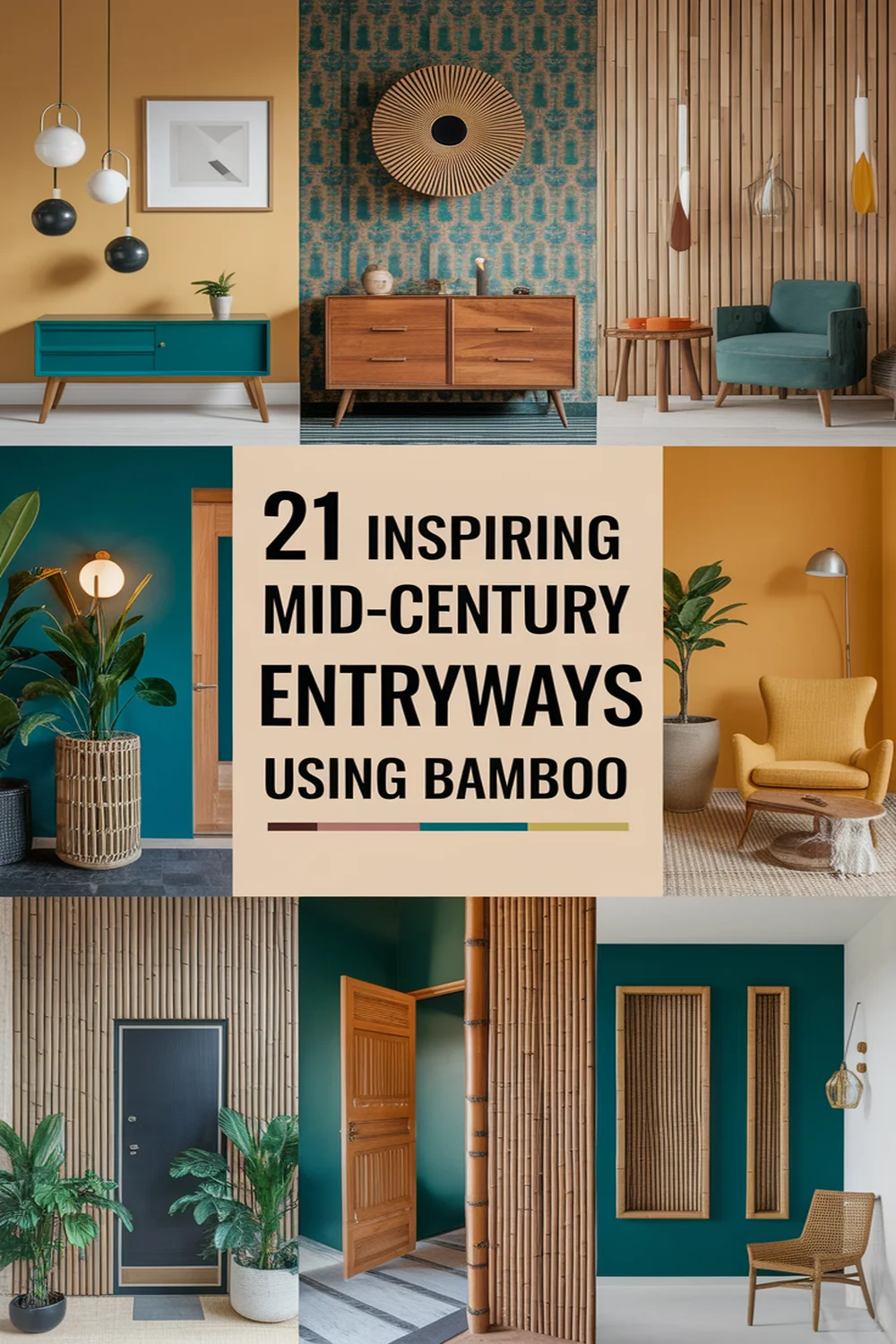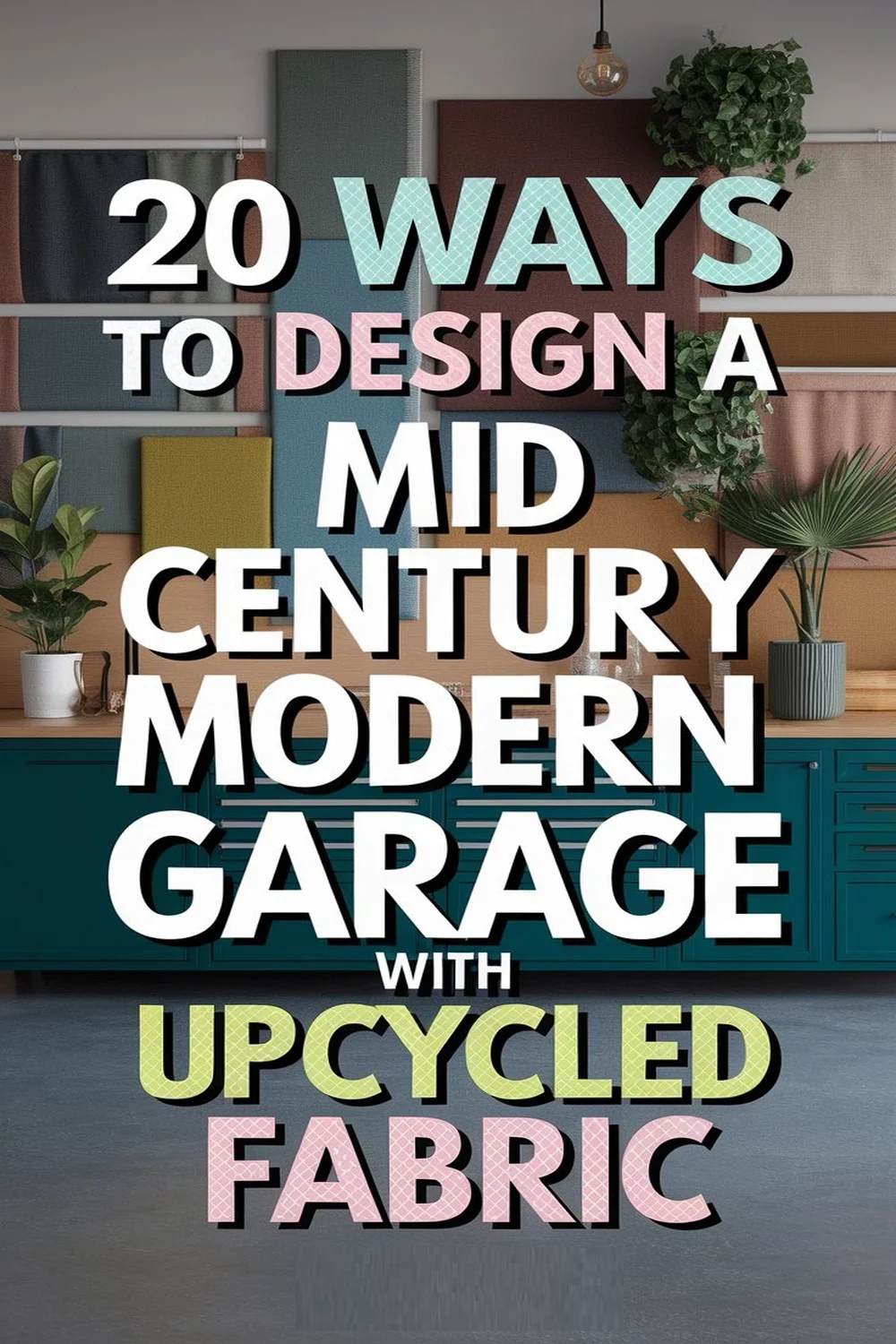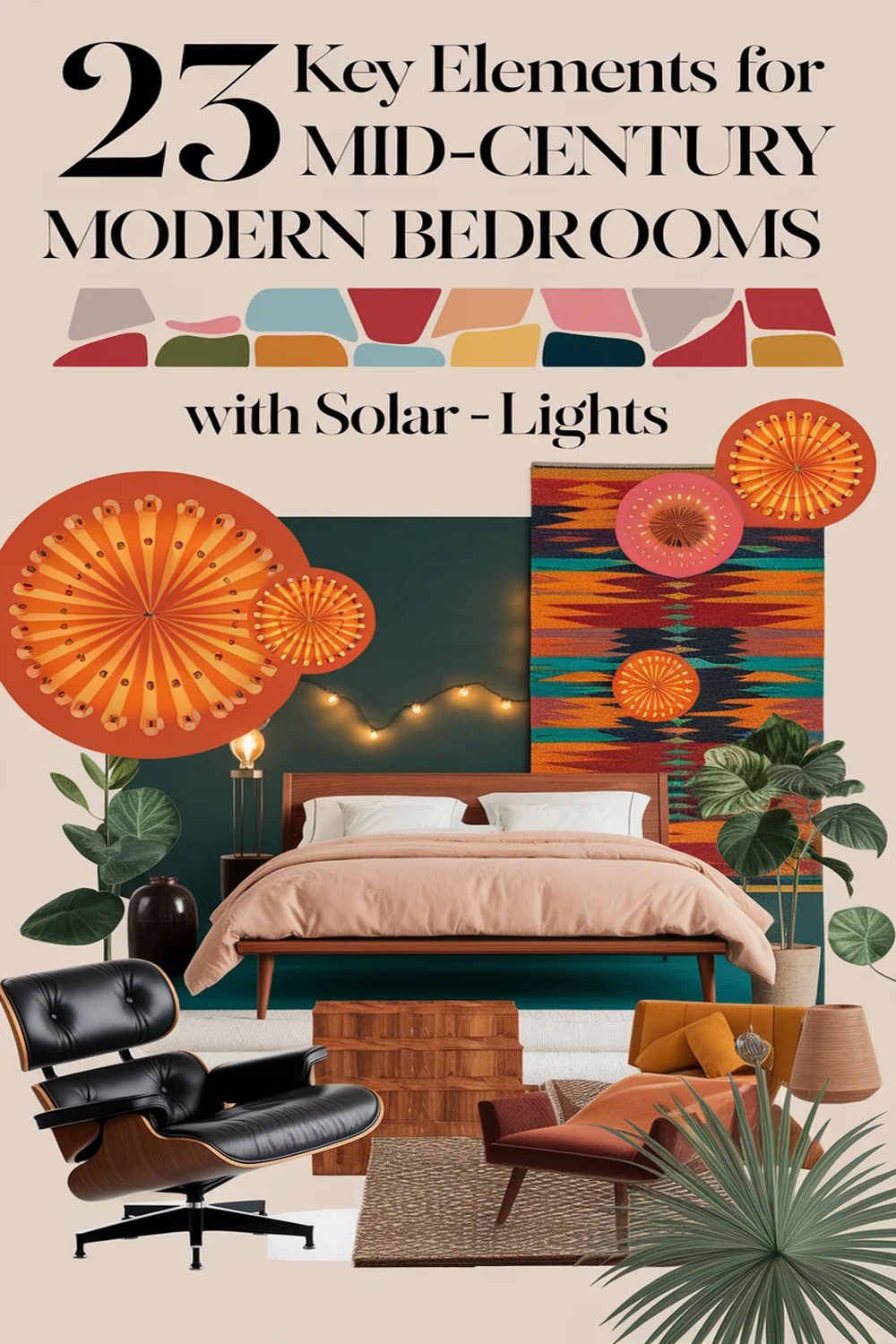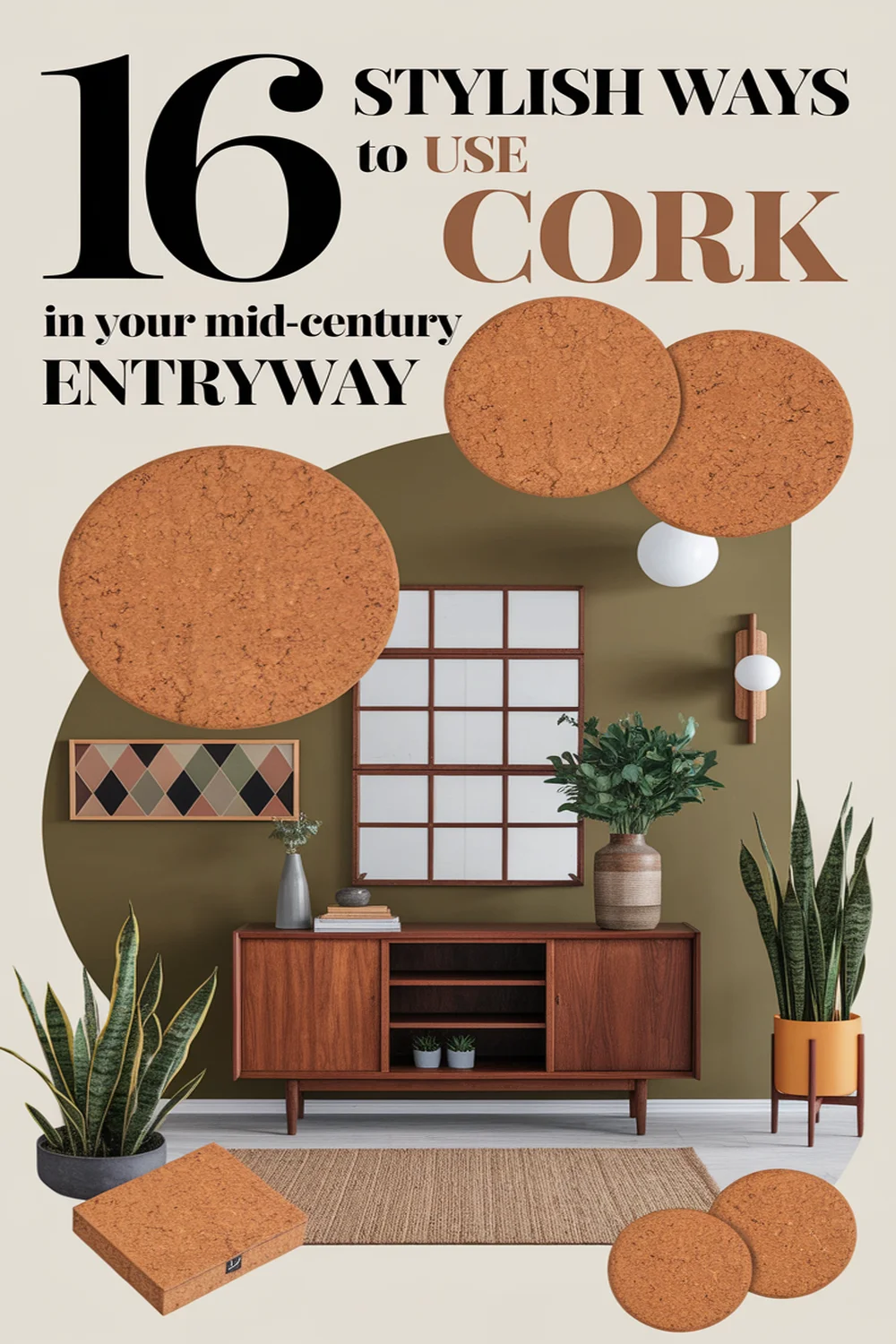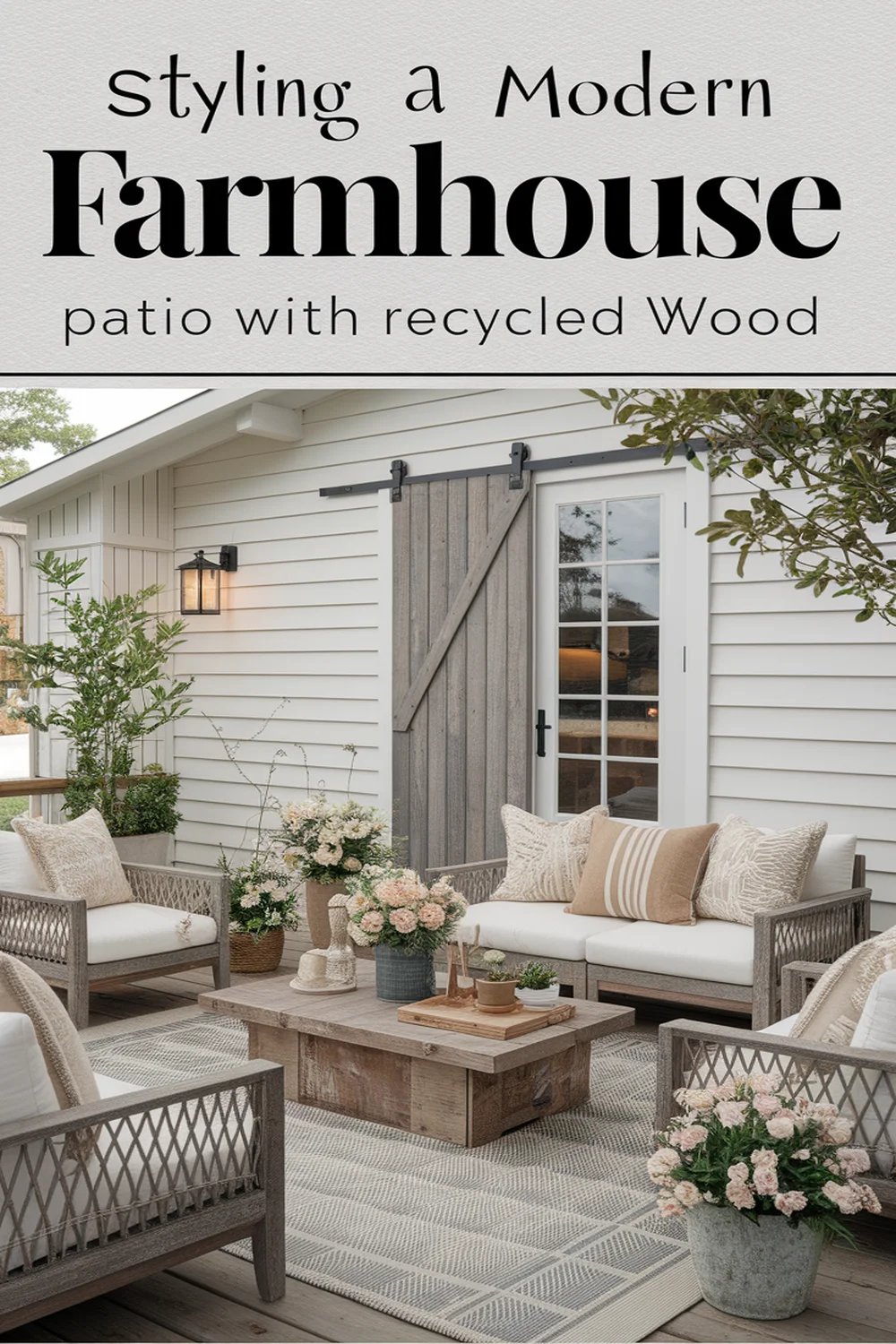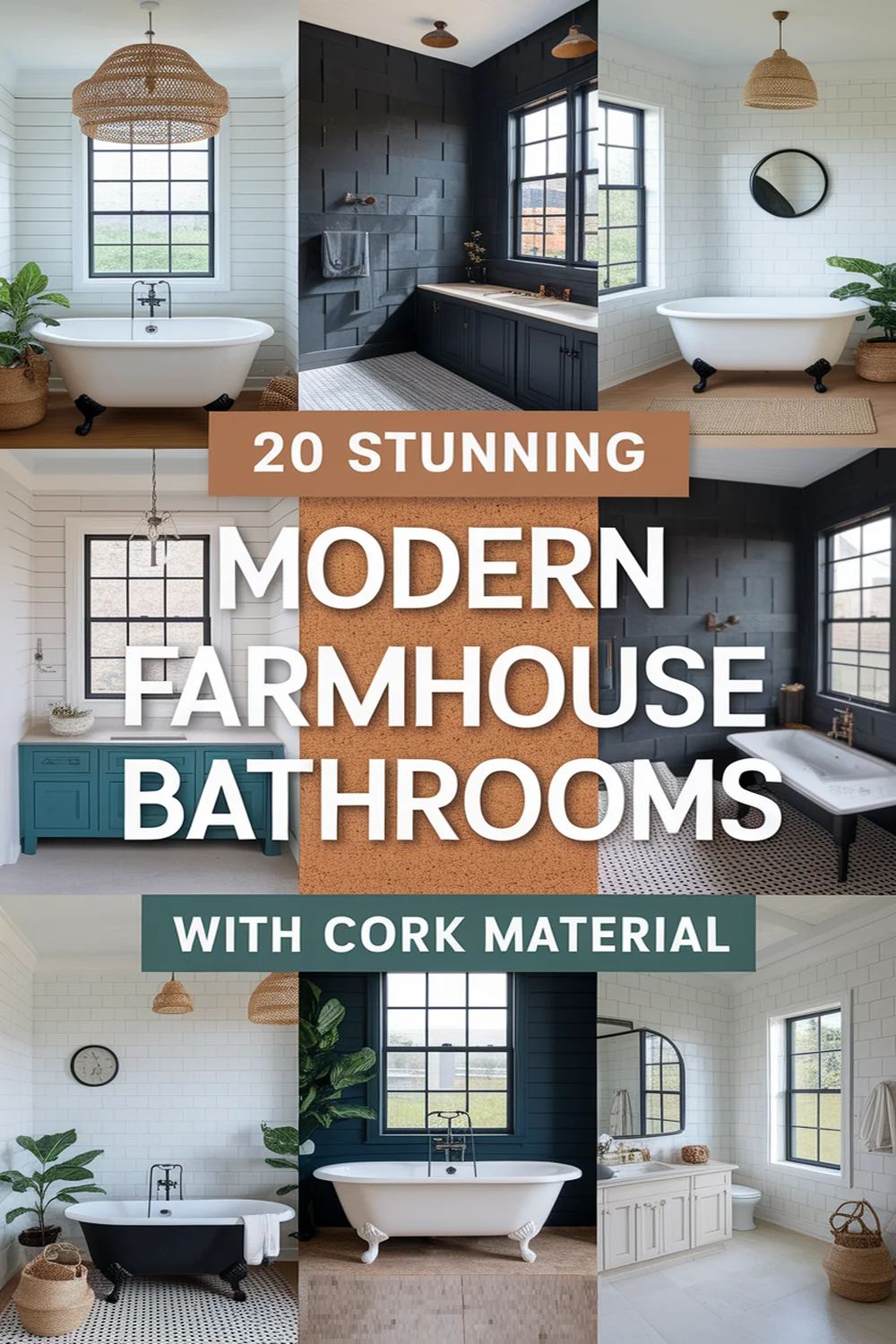This post may contain affiliate links. Please read our policy page.
Crafting a Mid-Century Modern kitchen with upcycled fabric materials inspires me every time! I start by selecting earthy tones and bold patterns to create a vibrant atmosphere. I find treasures at thrift stores, transforming them into cheerful pot holders and eye-catching wall art. Upholstering old furniture with geometric textiles adds character, while fabric storage solutions keep things organized. With a few DIY hacks, I bring nostalgic charm to life. There’s so much more to explore and create!
Understanding Mid-Century Modern Design Principles

When I think about Mid-Century Modern design, I’m immediately drawn to its seamless blend of form and function. This style embodies clean lines, organic shapes, and a minimalist aesthetic that refuses to compromise on practicality.
Each piece feels intentional, often showcasing natural materials like wood and metal, which create a warm, inviting atmosphere. I love how the open spaces encourage flow, allowing light to bounce freely off surfaces.
The integration of indoor and outdoor spaces is also key; large windows invite nature in, making the environment feel cohesive. Emphasizing simplicity, this design philosophy encourages thoughtful curation of furniture and decor.
Choosing the Right Color Palette
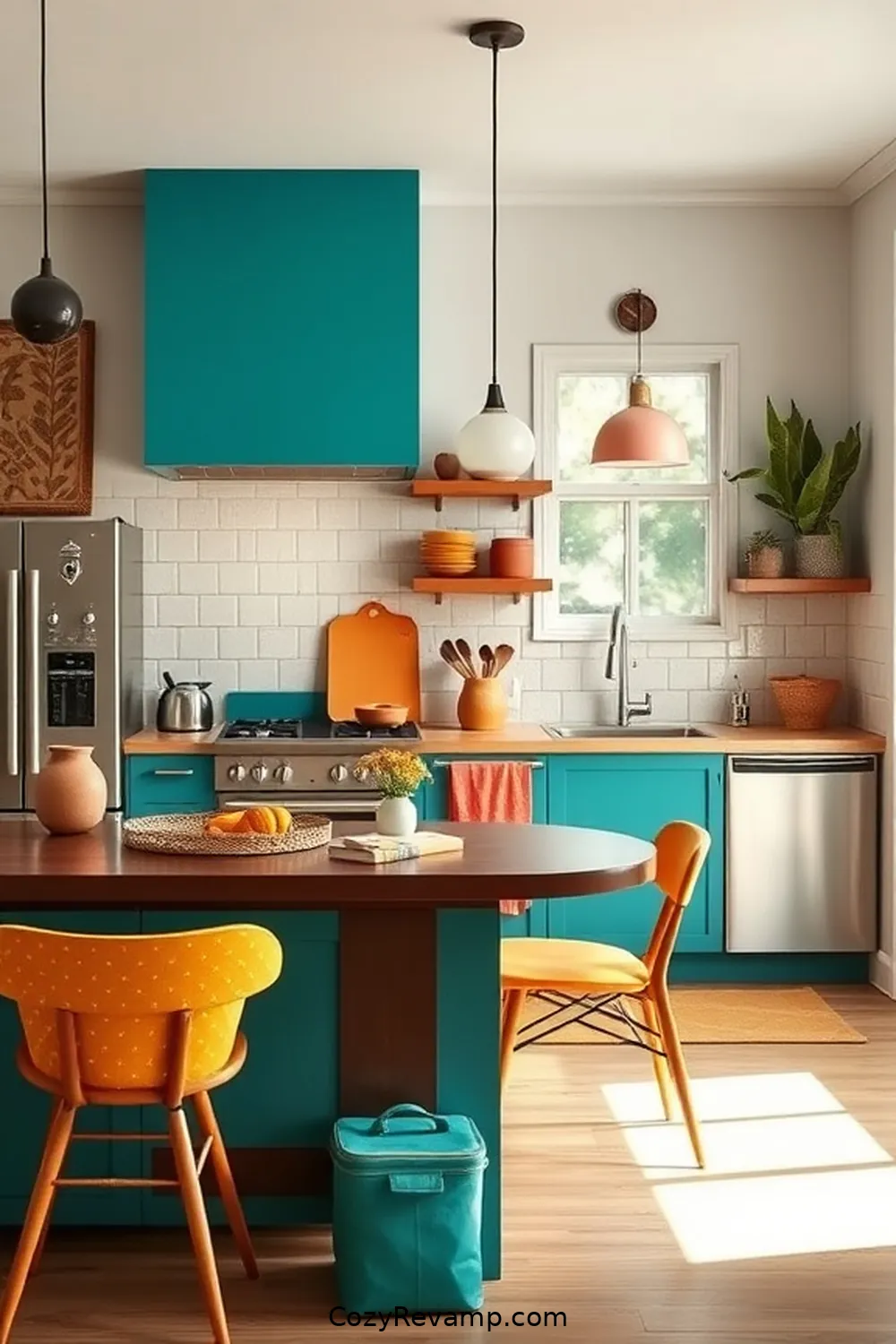
How can you choose the perfect color palette for your Mid-Century Modern kitchen? Start by capturing the essence of the era with earthy tones like olive green, mustard yellow, and warm browns.
Capture the essence of Mid-Century Modern design with earthy tones like olive green, mustard yellow, and warm browns.
These hues evoke a nostalgic charm while maintaining a modern edge. I love combining these shades with crisp whites or soft grays to create contrast and balance.
Consider using a bold accent color, such as teal or burnt orange, to make a statement—perhaps in your kitchenware or wall art.
When selecting fabrics, look for patterns that reflect geometric shapes or organic motifs.
Sourcing Upcycled Fabric Materials
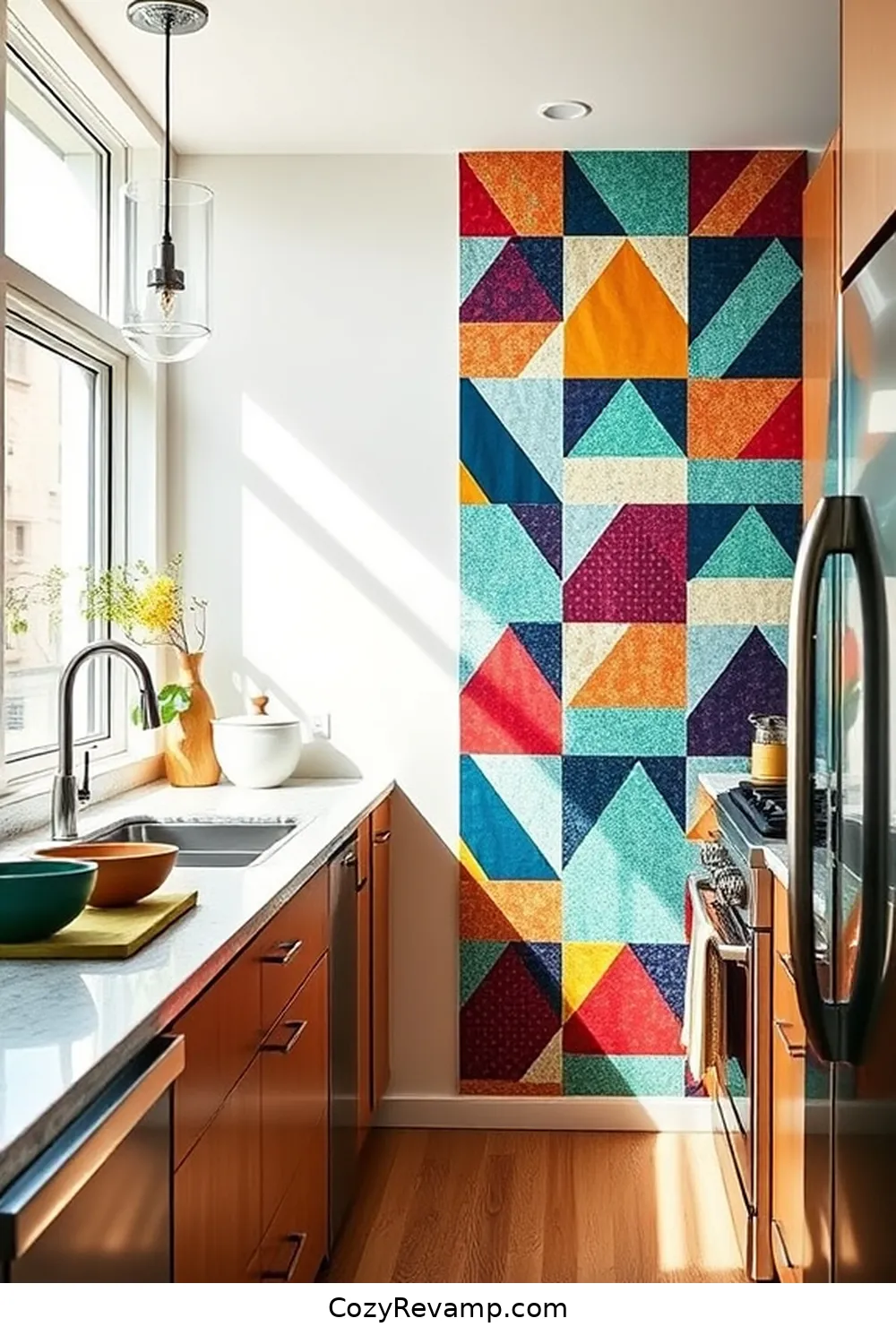
Sourcing upcycled fabric materials can transform your Mid-Century Modern kitchen into a sustainable haven.
I love hunting for unique fabrics that add character and charm. Here are some fantastic sources you might consider:
- Thrift stores: You can find vintage tablecloths and curtains with vibrant patterns.
- Garage sales: Often, people sell fabric remnants or old linens perfect for your project.
- Online marketplaces: Websites like Etsy or eBay can be treasure troves for unique fabric finds.
- Fabric recycling centers: These places often have a wide variety of discarded materials waiting for a new life.
With a little creativity, you can breathe new life into your kitchen using these upcycled treasures, making it an eco-friendly masterpiece.
Creating Fabric Wall Art
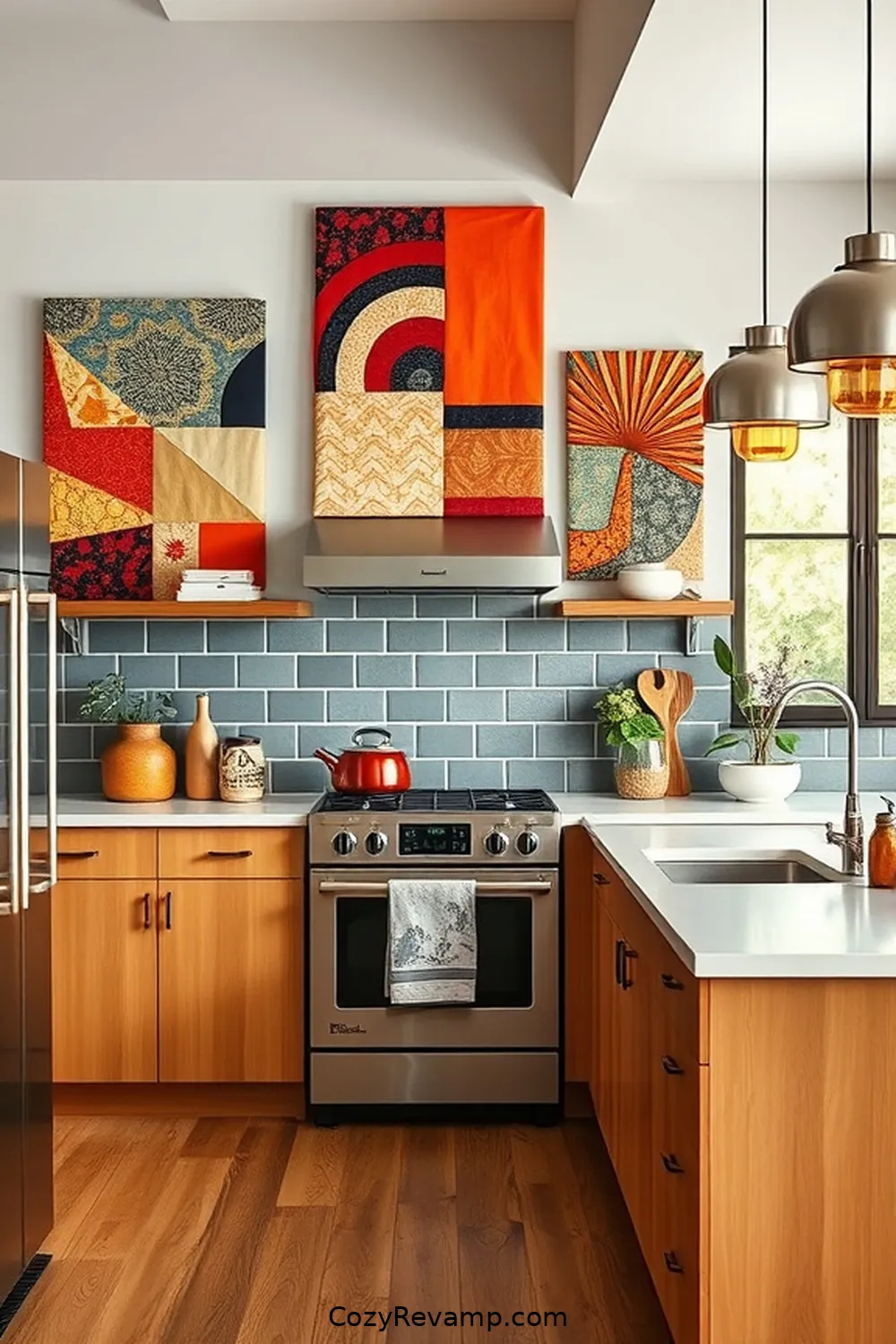
Creating fabric wall art can instantly elevate the aesthetic of your Mid-Century Modern kitchen, infusing it with personality and warmth.
I love selecting vibrant, geometric patterns that echo the era’s design ethos. Start by choosing a few fabric pieces you adore—think bold colors and unique textures.
Cut them into various shapes and sizes, then arrange them on a canvas or wooden board. Use a staple gun to secure the fabric, ensuring smooth edges and tight corners.
For an added touch, consider framing the finished piece in a sleek, minimalist frame. Hang it at eye level to create an enchanting focal point.
This simple project not only reflects your style but also gives new life to discarded textiles.
Upholstering Furniture With Vintage Textiles
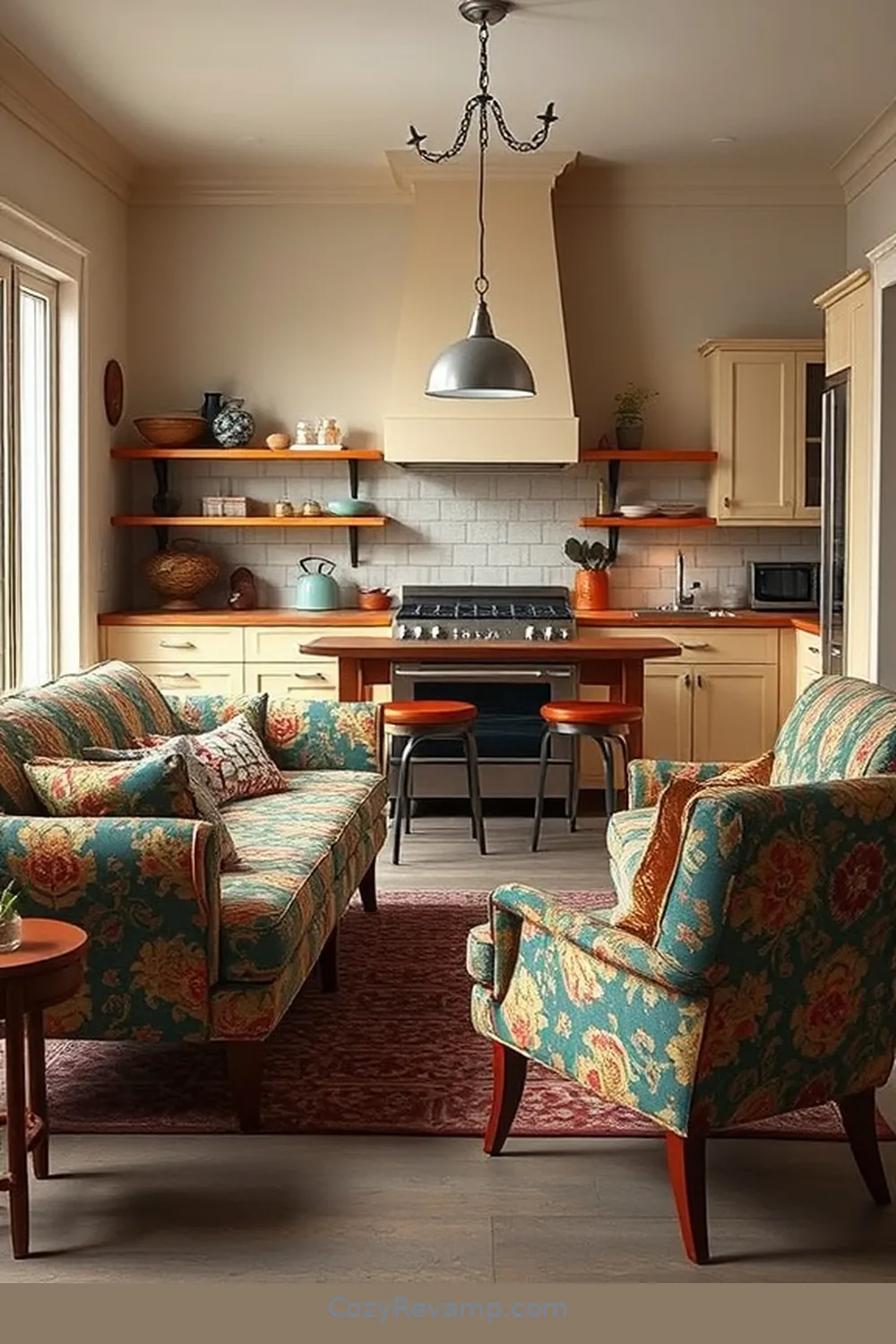
After adding a personal touch with your fabric wall art, consider taking your design game further by upholstering furniture with vintage textiles.
It’s a fantastic way to breathe new life into tired pieces while celebrating history and craftsmanship. Here’s what I love to keep in mind:
- Select Fabrics: Look for bold patterns or subtle textures that resonate with your aesthetic.
- Prepare Your Piece: Clean and repair the furniture, guaranteeing a solid foundation for your upholstery.
- Cut and Measure: Precision is key; measure your fabric carefully to avoid waste and guarantee a perfect fit.
- Secure the Upholstery: Use a staple gun for a tight finish, and don’t forget to add a layer of padding for comfort.
Transform your space, one vintage piece at a time!
Designing Custom Curtains and Drapes
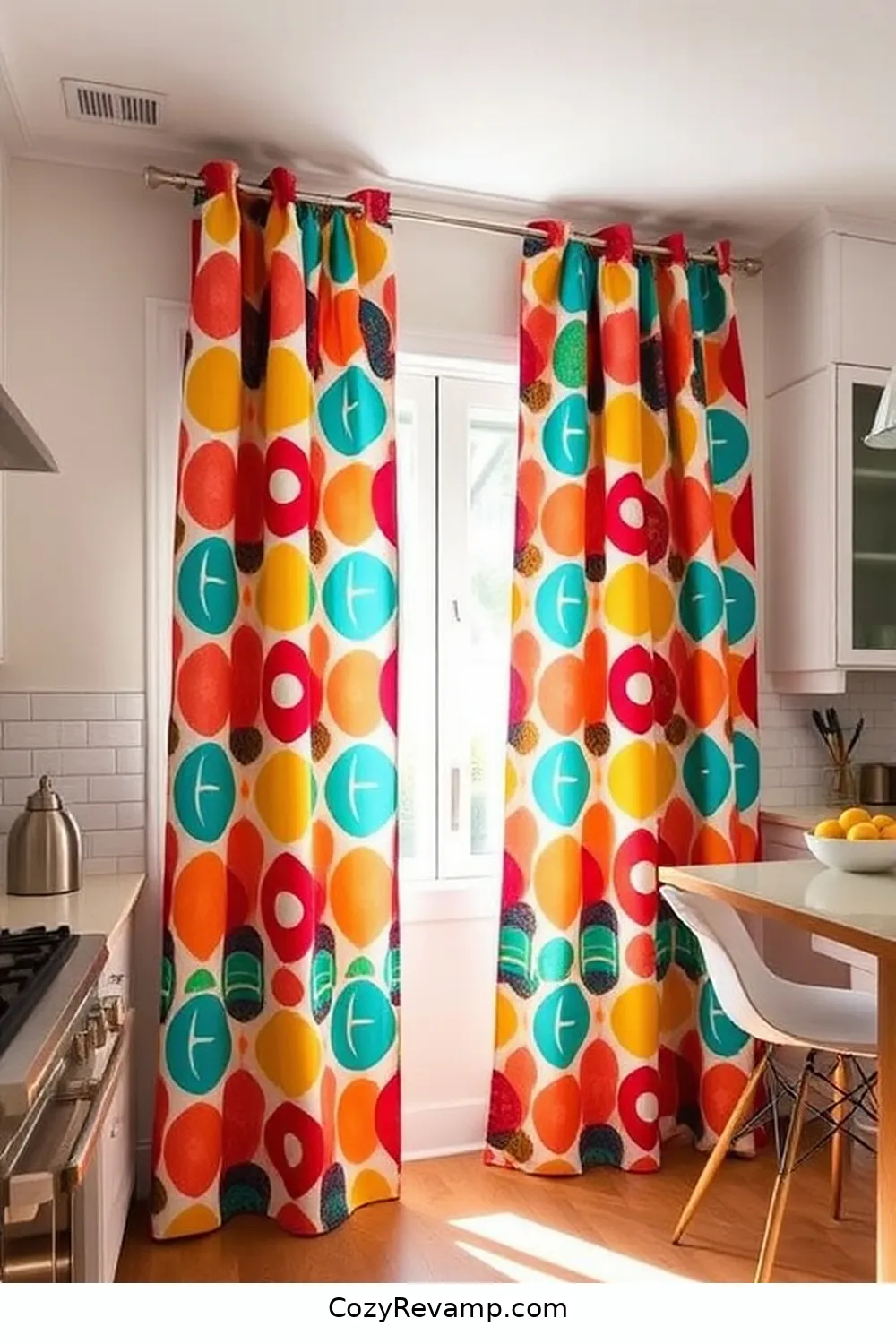
Curtains and drapes can transform a room, adding warmth and character while controlling light and privacy. I love the idea of using upcycled fabric to create unique window treatments that reflect my style.
First, I measure my windows carefully, considering the desired length and fullness. Choosing a bold, patterned fabric from my vintage stash, I cut it to size, allowing for hems. I opt for a simple rod pocket design, making installation a breeze.
To enhance the mid-century modern vibe, I select retro-inspired hardware that compliments my kitchen’s aesthetic. Finally, I hang the curtains, adjusting them for that perfect drape. With each piece, I feel a sense of accomplishment, knowing I’ve crafted something truly one-of-a-kind.
Recommended Items
Ready to bring your mid-century modern kitchen to life? Check out our recommended products and equipment!
Products
Crafting Table Linens From Fabric Scraps
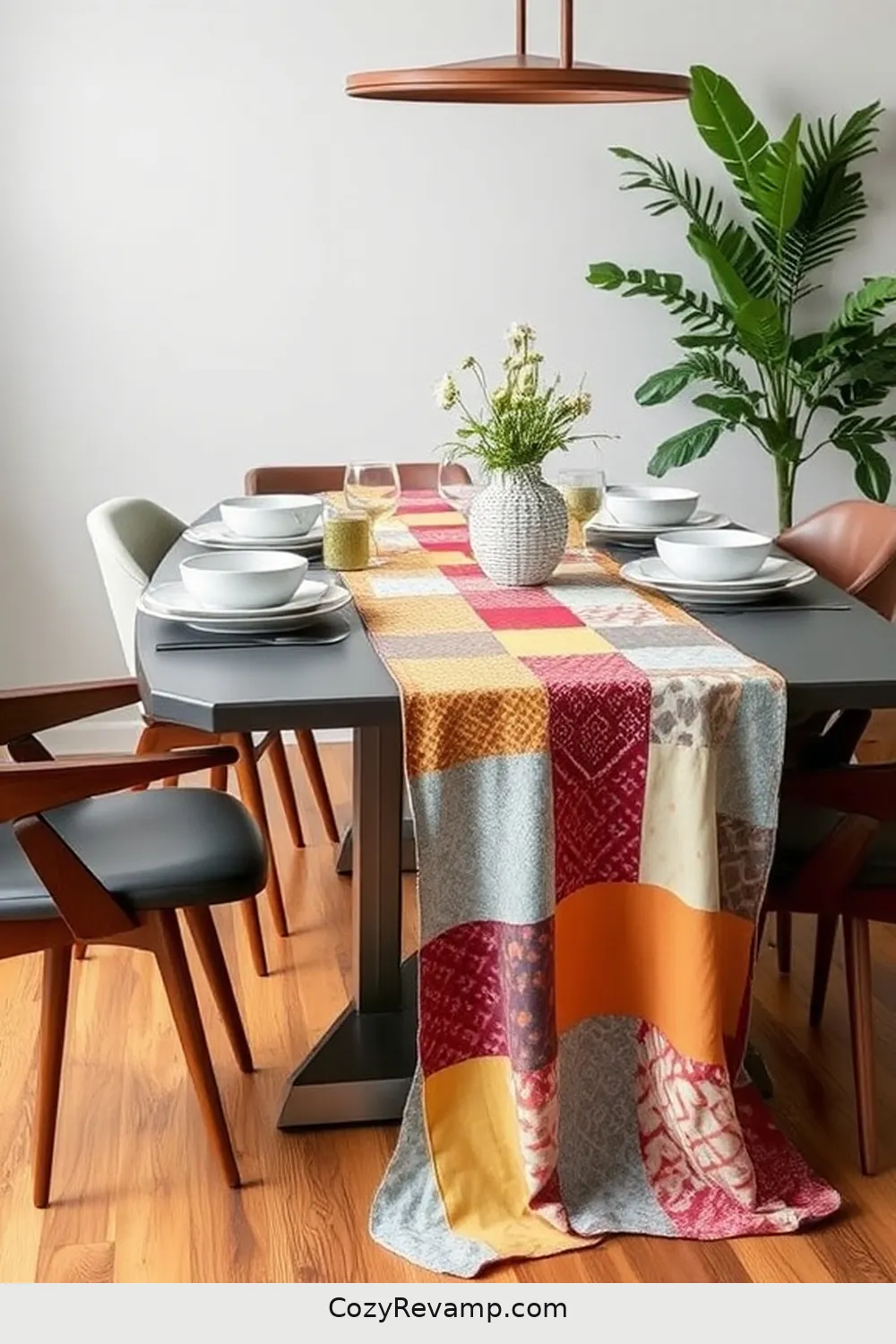
While I rummage through my collection of fabric scraps, inspiration strikes for crafting unique table linens that can elevate my dining experience. The vibrant colors and textures beckon me to create something special.
Rummaging through fabric scraps, I find inspiration to craft unique table linens that elevate my dining experience.
Here’s how I turn those bits and pieces into beautiful table settings:
- Patchwork Tablecloth: Combining various fabric squares to form an eclectic yet cohesive look.
- Napkin Sets: Sewing simple square napkins from complementary fabrics for a fresh touch.
- Table Runner: Crafting a stylish runner that showcases larger pieces, adding flair to the center of the table.
- Coasters: Stitched or quilted coasters using colorful remnants to protect surfaces while adding charm.
With these simple ideas, my kitchen transforms into a warm, inviting space perfect for gatherings.
Step-by-Step Guide to a Mid-Century Kitchen
Making Cushions and Pillows for Seating
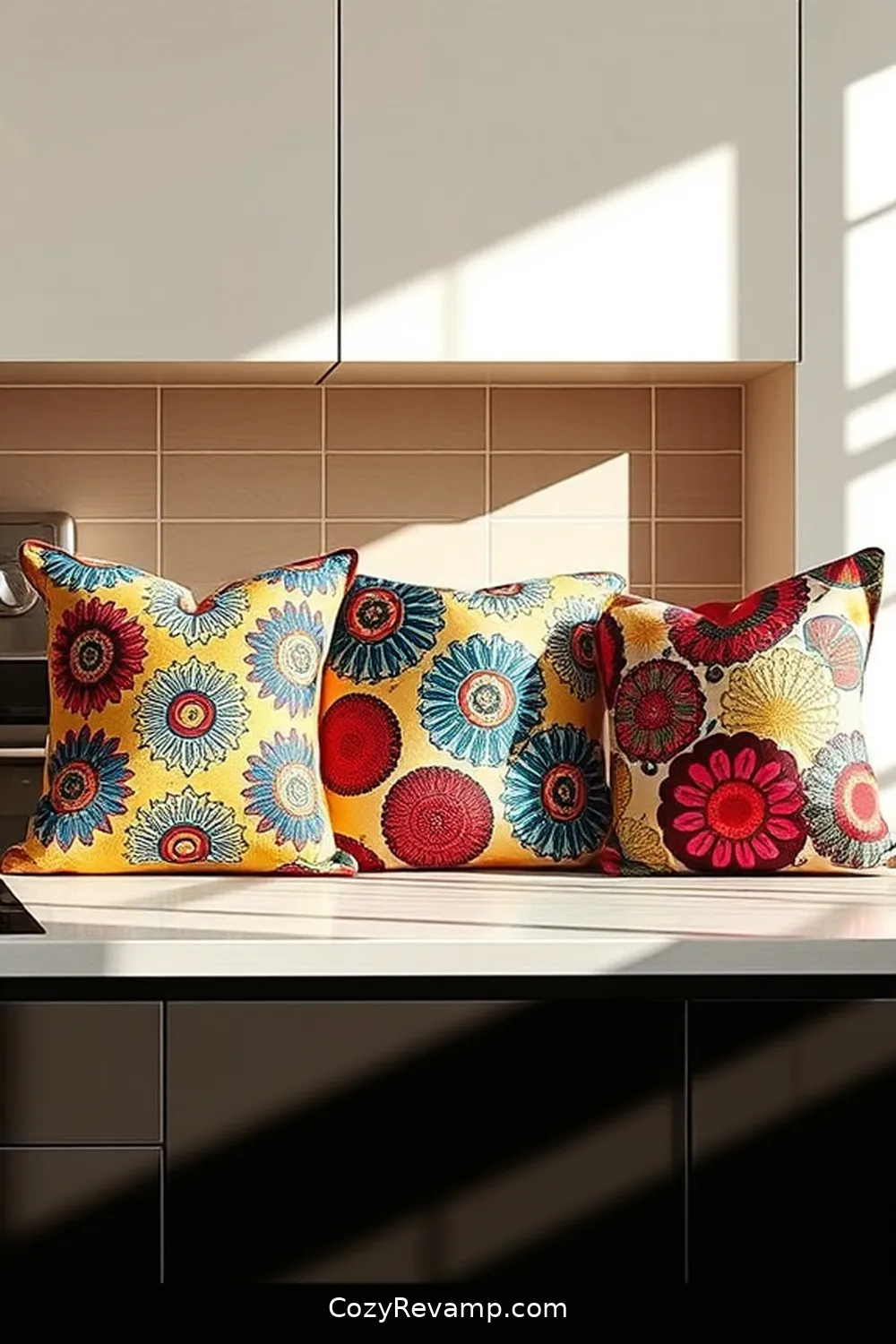
Cushions and pillows can transform any seating area into a cozy retreat, inviting relaxation and conversation. Using upcycled fabric, you can create unique pieces that reflect your style. Here’s a simple guide to get started:
| Material | Size | Recommended Use |
|---|---|---|
| Cotton | 18″x18″ | General seating |
| Velvet | 20″x20″ | Accent pillows |
| Denim | 16″x20″ | Outdoor cushions |
| Canvas | 22″x22″ | Floor cushions |
Cut your fabric to size, and don’t forget to add a half-inch seam allowance. Fill with foam or recycled stuffing, then sew it up or use fabric glue for a no-sew option. Your new cushions will not only enhance comfort but also add a pop of color to your kitchen!
Refurbishing Cabinets With Fabric Panels
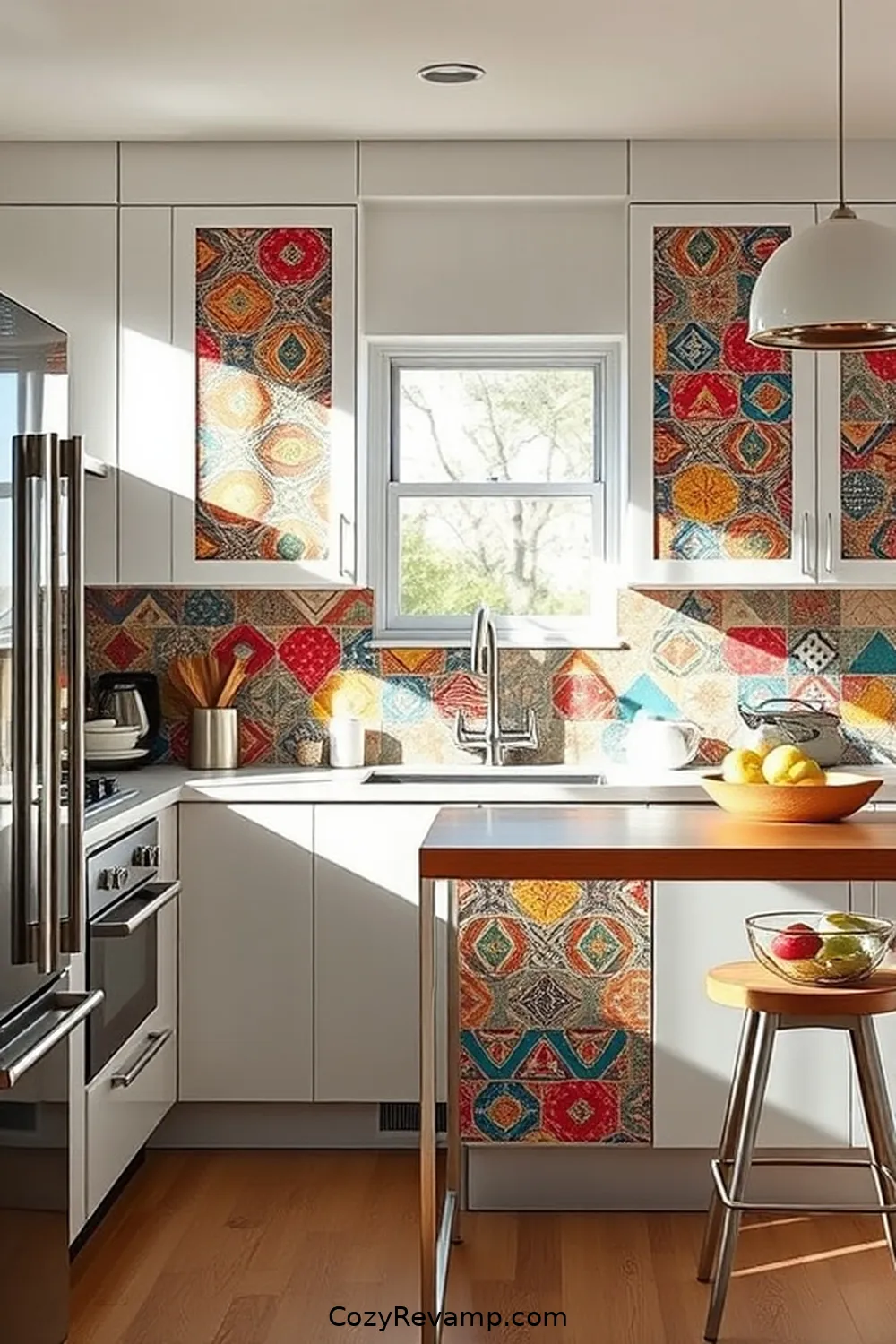
Transforming your kitchen cabinets with fabric panels can breathe new life into your space and reflect your personal style.
Revitalize your kitchen with fabric panels on cabinets, showcasing your unique style while adding texture and color.
I love how fabric can add texture and color, making even the dullest cabinets feel vibrant. Here’s how I did it:
- Choose a fabric that complements your kitchen’s color palette—think bold prints or soft pastels.
- Remove cabinet doors carefully, ensuring you keep the hardware intact for reattachment.
- Cut fabric panels to size, allowing for a bit of overhang to wrap around the edges for a clean finish.
- Use adhesive spray to secure the fabric, smoothing out bubbles for a polished look.
This project not only revitalizes my kitchen but also showcases my unique aesthetic!
Utilizing Fabric for Backsplashes
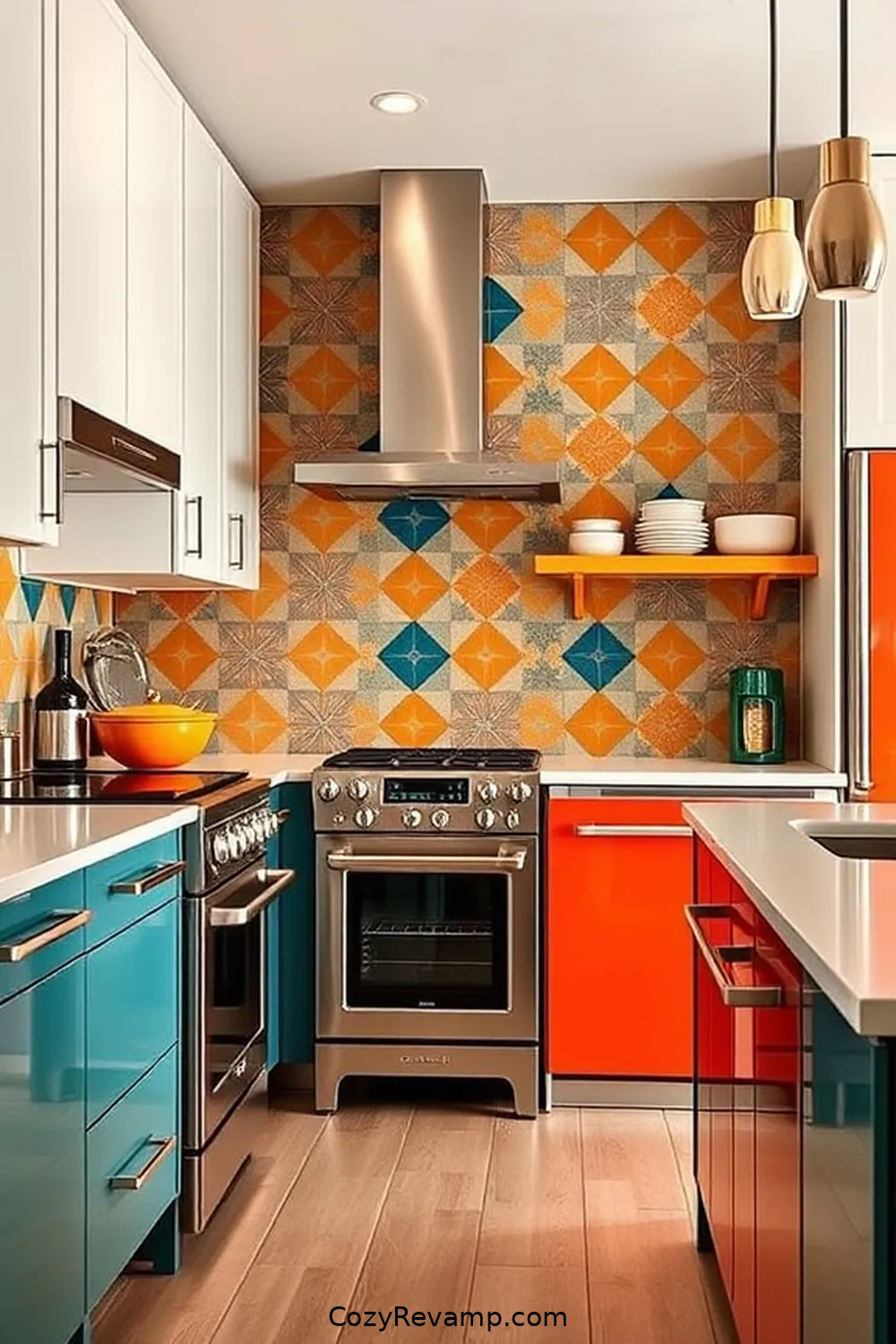
After giving my cabinets a fresh look with fabric panels, I realized that the backsplash could use a similar touch of personality. I chose a vibrant, upcycled fabric that echoed Mid-Century Modern designs, blending colors and patterns that popped against my cabinetry.
For installation, I cut the fabric to fit the backsplash area and adhered it using a strong fabric glue. To protect it from moisture and stains, I applied a clear acrylic sealant, ensuring durability without sacrificing style.
This method not only added warmth and texture to my kitchen but also sparked conversations. The fabric backsplash became a focal point, showcasing my creativity while remaining practical.
It’s a simple yet effective way to infuse character into any space!
Incorporating Fabric Storage Solutions
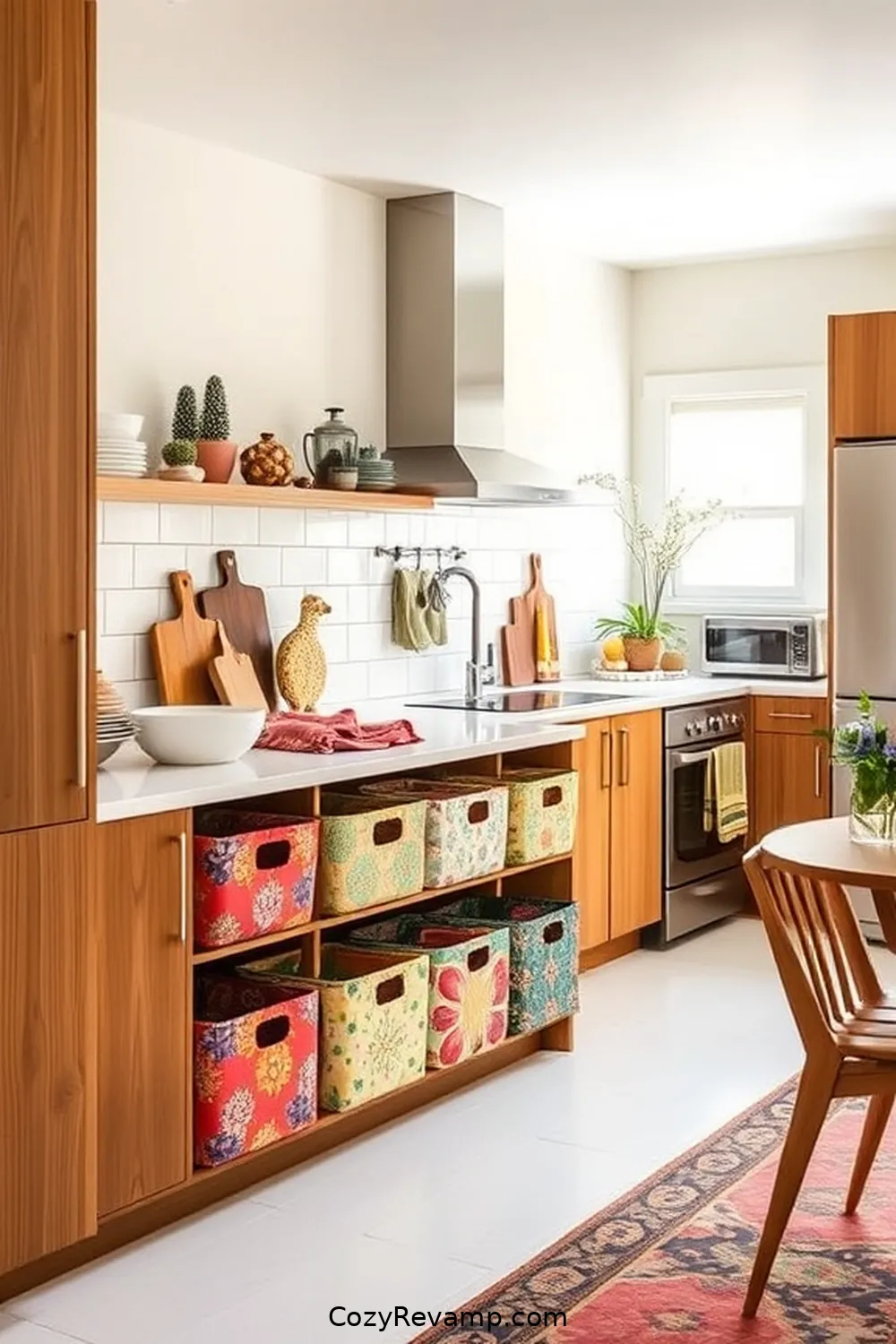
While exploring ways to elevate my kitchen’s functionality, I discovered that fabric storage solutions could seamlessly blend style and practicality.
Using vibrant, upcycled fabrics not only adds a splash of color but also provides unique ways to organize my space. Here’s what I’ve incorporated:
- Hanging fabric pockets: Perfect for utensils and small gadgets, they save counter space while adding charm.
- Fabric bins: These lined baskets can hold everything from pantry items to dish towels, creating a cohesive look.
- Sewn fabric covers: I made covers for open shelving, hiding clutter while allowing a peek of color.
- Cushioned seating with storage: A stylish bench doubles as a spot for cushions and kitchen tools.
These solutions transformed my kitchen into a functional masterpiece!
Designing Unique Fabric-Made Accessories
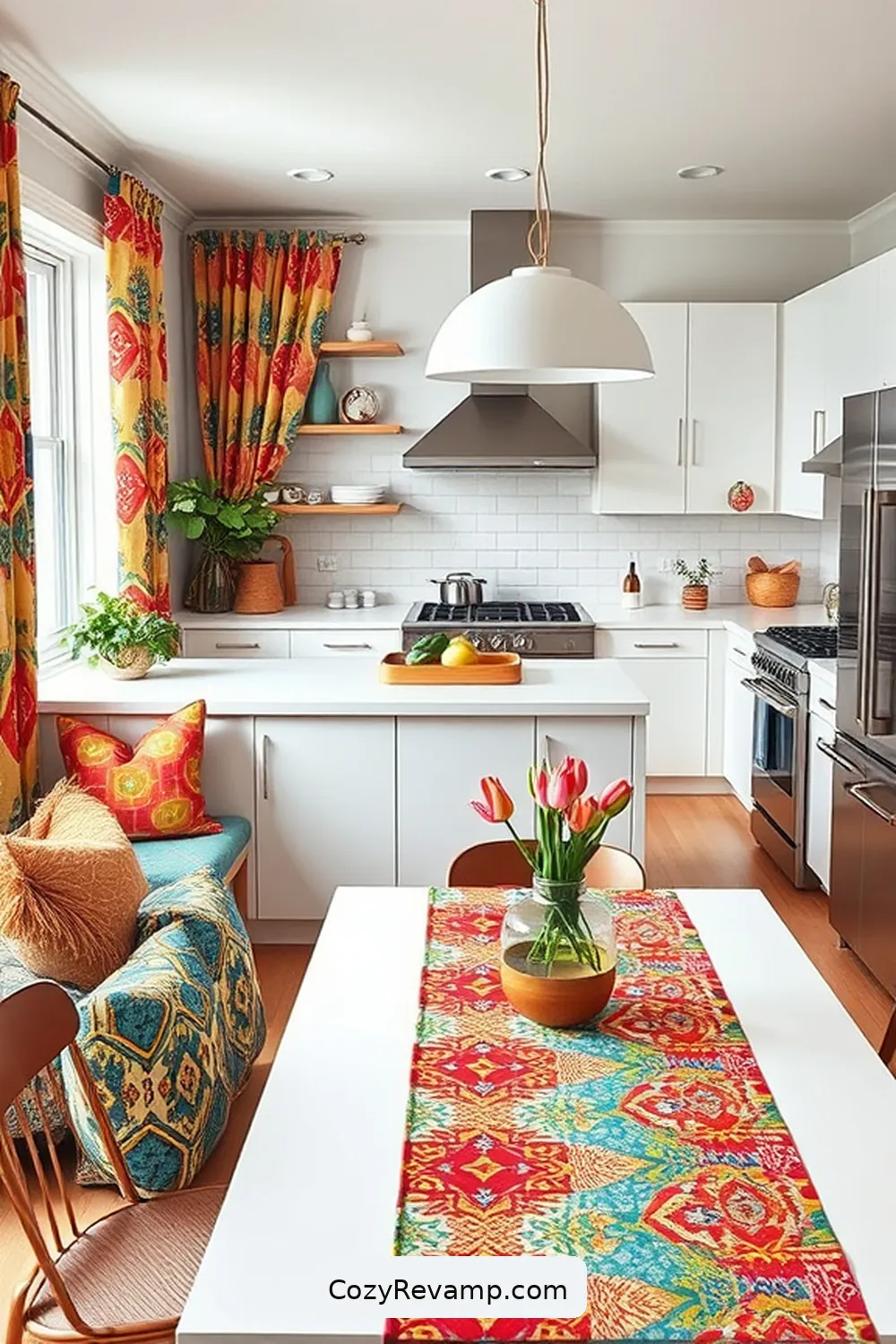
As I dove into the world of fabric-made accessories, I realized how these creations could elevate the overall aesthetics of my kitchen. I began by crafting vibrant pot holders from colorful vintage textiles, adding a pop of personality to my countertop.
Next, I designed cheerful fabric curtains, using lightweight cotton to filter natural light while maintaining privacy. I even created a cozy runner for my dining table, combining patchwork patterns that reflect the mid-century modern vibe.
Each piece not only serves a functional purpose but also tells a story, sparking conversation among guests. By mixing textures and patterns, I transformed my kitchen into a unique, inviting space that perfectly embodies my personal style.
Tips for Maintaining Upcycled Fabric Projects
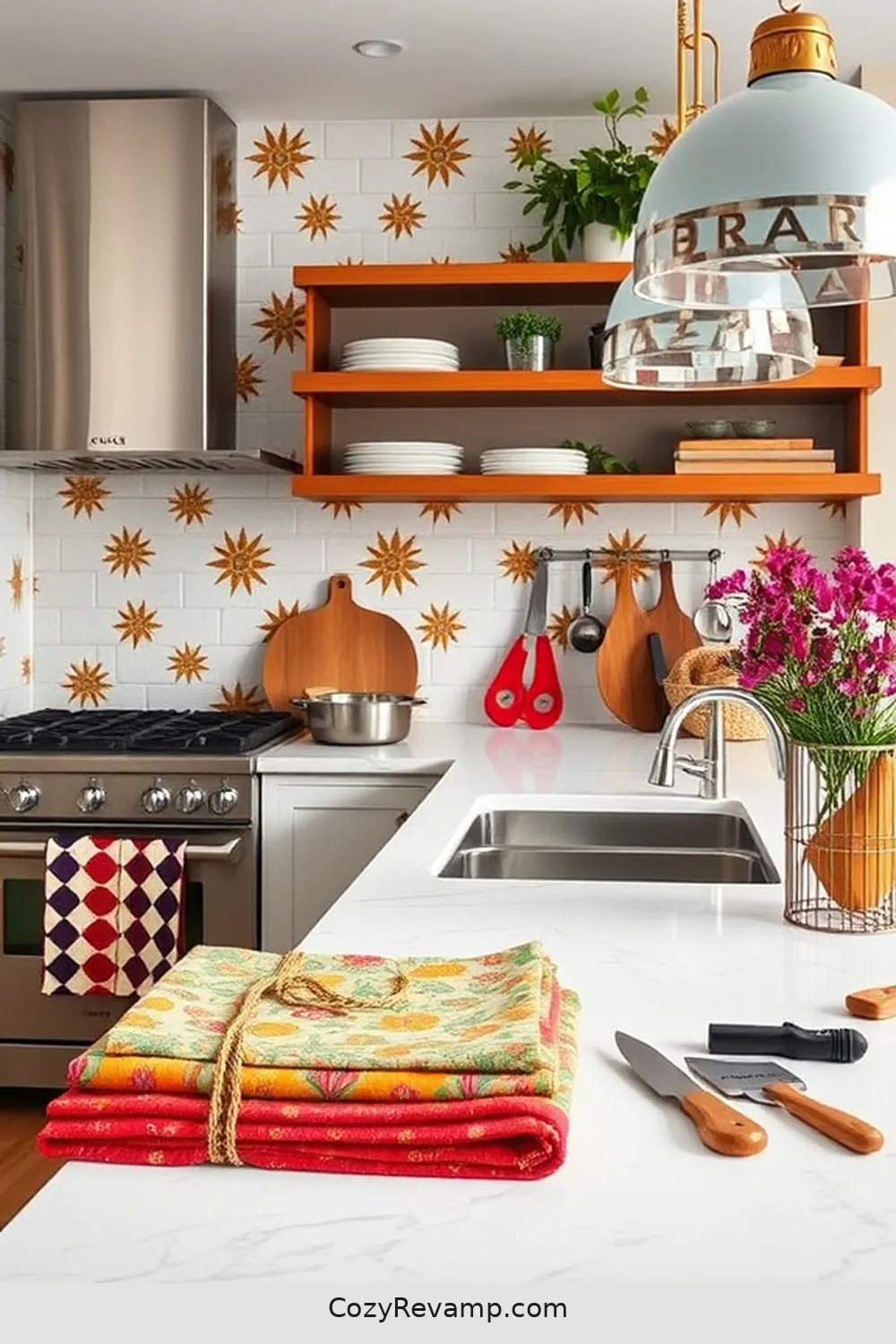
Although I love my upcycled fabric projects, keeping them looking fresh requires a bit of care.
I’ve learned a few essential tips along the way that make all the difference.
- Spot Clean Regularly: Use a mild soap and water solution to tackle spills immediately.
- Avoid Direct Sunlight: Keep items away from harsh sunlight to prevent fading.
- Use a Fabric Protector: Spray a fabric-safe protector to enhance durability and repel stains.
- Gentle Washing: If machine-washing is necessary, opt for a gentle cycle and cold water to preserve the fabric’s integrity.
Showcasing Your Mid-Century Modern Kitchen Design
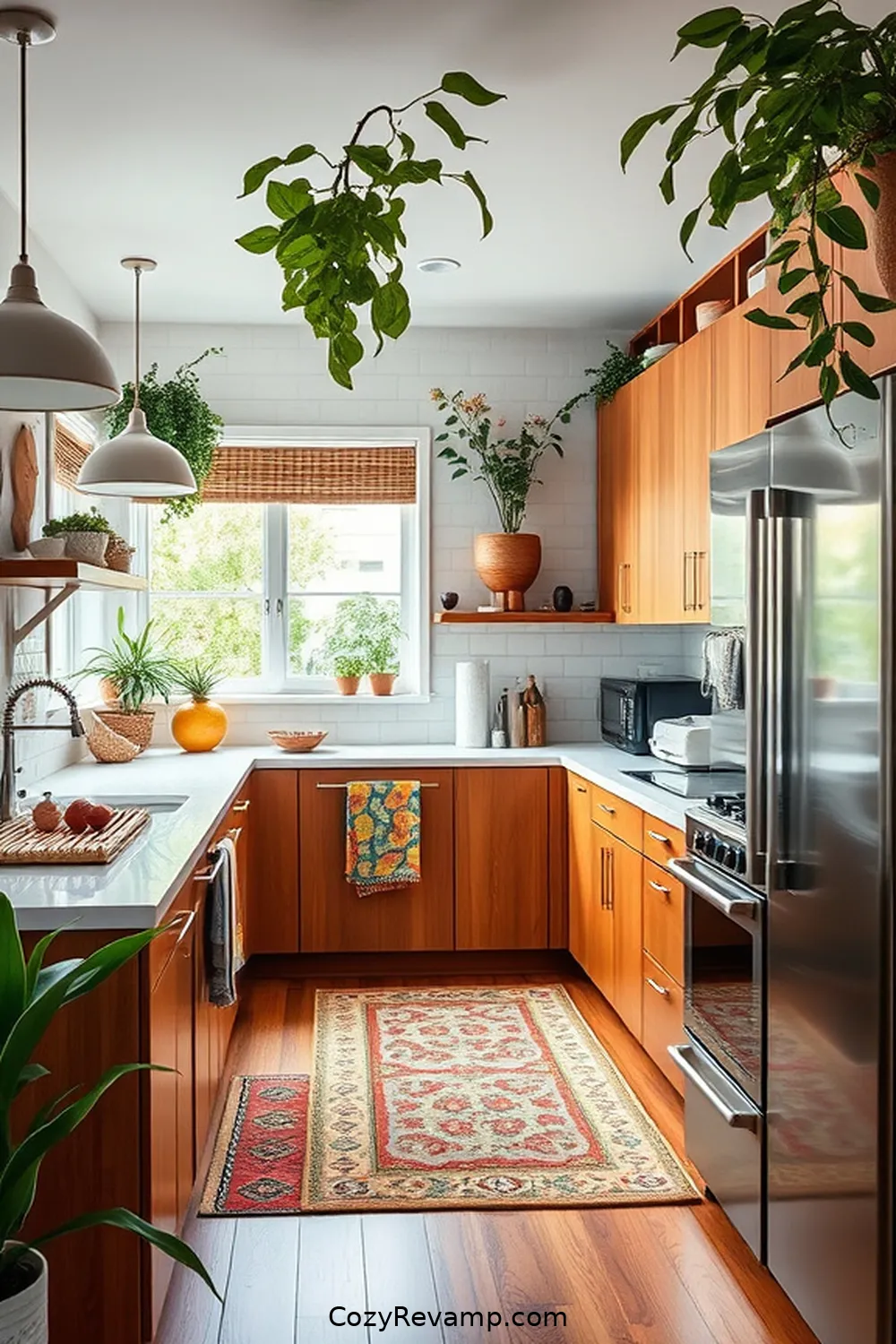
When showcasing my Mid-Century Modern kitchen design, I focus on blending functionality with aesthetic appeal. Bold colors like avocado green and mustard yellow pop against sleek, minimalist cabinetry, creating an inviting atmosphere.
I use geometric patterns in my upcycled fabric curtains, adding a touch of nostalgia while keeping the space airy. The open shelving displays vintage dishware, seamlessly merging form and function.
Lighting plays an essential role; I choose pendant fixtures with clean lines that illuminate without overpowering. I also incorporate natural elements, like a reclaimed wood table, to enhance warmth.
Lighting is vital; I opt for sleek pendant fixtures that subtly brighten the space, complemented by the warmth of reclaimed wood.
Each detail reflects my personality, inviting others to appreciate the charm of this era. Ultimately, it’s about creating a space that’s not just beautiful but also livable.

